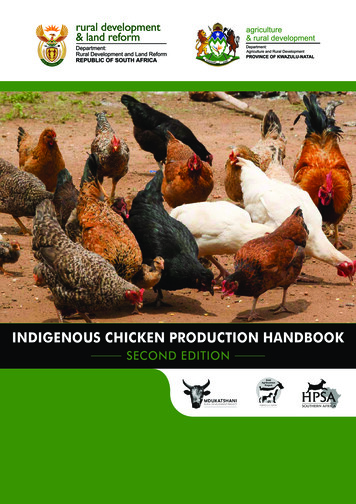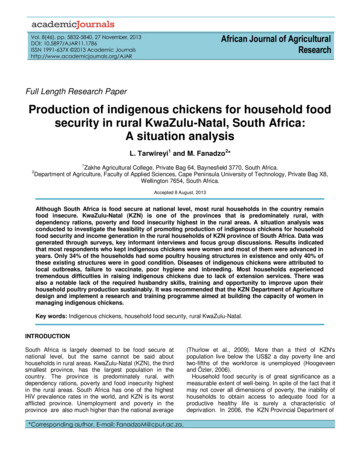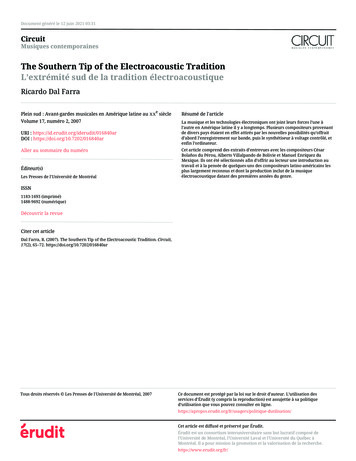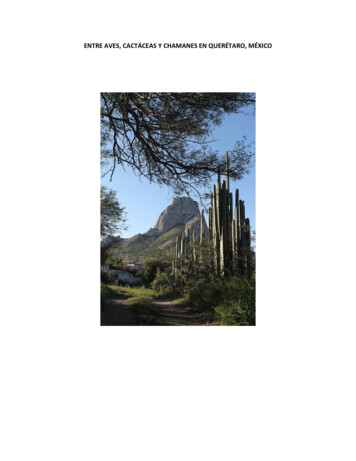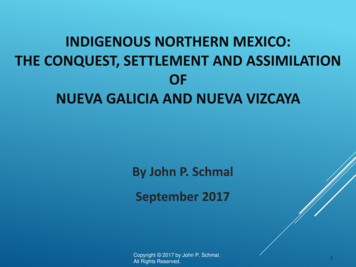
Transcription
INDIGENOUS NORTHERN MEXICO:THE CONQUEST, SETTLEMENT AND ASSIMILATIONOFNUEVA GALICIA AND NUEVA VIZCAYABy John P. SchmalSeptember 2017Copyright 2017 by John P. Schmal.All Rights Reserved.1
Indigenous México Today Speakers of Indigenous Languages: 6.7 Million (2010) Percent of People Speaking Indigenous Languages: 6.7% (2010) Persons Who Consider Themselves Indigenous: 15.7 Million Population of México in 2016: 129 Million Number of Ethnolinguistic Groups: 68 Number of Language Families: 11 Number of Language Variants: 3642
Indigenous México TodayCopyright 2013 by John P. Schmal.All Rights Reserved.3
The Aztec EmpireIn this presentation, we will discuss the indigenous peoples wholived north of the Aztec Empire. Nueva Galicia and Nueva Vizcaya were north of the area that made up theAztec Empire (which was conquered by the Spaniards in 1521). The Aztecs hadno military influence in these northern areas before 1521, but they did havetrading relationships with some of the indigenous groups.Source: University of California at /Conquest/1-Aztec Empire Map.pngCopyright 2017 by John P. Schmal.All Rights Reserved.4
The Uto-Aztecan Linguistic Group (61 Languages)Many of the indigenous groups living in Northern Mexico and theSouthwestern U.S. belonged to the Uto-Aztecan linguistic group.Northern Uto-Aztecan(13 Languages) – primarilyU.S.-based (Hopi, Comanche& Paiute)Southern Uto-Aztecan -– ofMexico(48 Languages)2. Aztecan/Náhuatl1. Sonoran (19 Languages) ofnortheastern México (Mayo, Opata,Yaqui, Cora, Huichol, Tarahumara &Tepehuán – groups in Sonora,Sinaloa, Nayarit, Chihuahua andDurango)(29 Languages) – Theselanguages are spreadthrough many states ofMéxico, in particular thecentral and easternsections.Source: Lewis, M. Paul (ed.), “Ethnologue: Languages of the World” (16th Edition: SIL International, 2009).5
The Uto-Aztecan Language Group: MapSource: American Journal of Linguistics.6
Nueva Galicia’s Indigenous PeopleEstablished in 1548, the Spanish province of NuevaGalicia embraced 180,000 kilometers and includedmost of present-day Jalisco, Nayarit, Aguascalientesand Zacatecas. Across this broad range of territory,a wide array of indigenous groups lived during theSixteenth Century.Domingo Lázaro de Arregui, in his Descripción de laNueva Galicia - published in 1621 - wrote that 72languages were spoken in the Spanish colonialprovince of Nueva Galicia.Source: Domingo Lázaro de Arregui, “Descripción de la Nueva Galicia” (Dec. 24, 1621).Copyright 2017 by John P. Schmal.All Rights Reserved.7
The Chichimecas: Conquest and Assimilation1)The occupation and conquests of Nuño de Guzmán (1529-1531) left atrail of devastation and terror across Jalisco and Zacatecas.2)The influence of epidemics played a significant role in reducing theindigenous populations (especially in western Jalisco).3)The Mixtõn Rebellion (1540-1542). The aftermath of this bloodyconflict led to widespread enslavement of the Caxcanes.4)The Chichimeca War (1550-1590). This was forty-year conflict waswaged by nearly all the natives of Zacatecas. Spanish settlements cameunder attack and most were evacuated and/or depopulated.5)The gradual assimilation that resulted from the “peace by purchase”policy of the Marqués de Villamanrique who offered the Chichimecasincentives for peaceful settlement (conversion, food, clothing, landsand agricultural implements).Copyright 2017 by John P. Schmal.All Rights Reserved.8
The Chichimeca Road Block“Chichimecas” was the collective name for a wide range of indigenous groups livingthroughout Zacatecas, Aguascalientes, Durango, parts of Jalisco and parts ofGuanajuato. It is believed that most of these groups spoke languages that wererelated to Náhuatl (the language of the Aztecs and Mexica) and part of the UtoAztecan Stock.at strategically located depots. . But the greatest contribution to the pacificationprocess was the vast quantity of food, mostly maize and beef.The clothing shipped included coarse woolen cloth, coarse blankets, woven petticoats,shirts, hats and capes. The agricultural implements included plows, hoes, axes,hatchets, leather saddles, and slaughtering knives. But the greatest contribution tothe pacification process was the vast quantity of food, mostly maize and beef.The Chichimeca War ended shortly after 1590. Essentially the Spaniards had bribedthe Chichimecas to make peace by offering them a more luxurious existence withthe trappings of the so-called “civilized world.”Source: Philip Wayne Powell, “Soldiers, Indians and Silver: North America's First Frontier War" (Tempe, Arizona: Center forLatin American Studies, Arizona State University, 1973).Copyright 2017 by John P. Schmal.All Rights Reserved.9
The Chichimeca Nations in the Sixteenth Century10Source: Wikipedia, “Chichimeca War.”Copyright 2017 by John P. Schmal.All Rights Reserved.10
The Chichimecas: Assimilation & MestizajeChristian Indians from the south (especially Tlaxcalans) settled among the Chichimecas tohelp them adapt to their new existence. In the meantime, Catholic missionaries hadbegan a vigorous campaign to win the hearts and souls of the native people of Zacatecas.By 1596, fourteen monasteries dotted the present-day area of Zacatecas. The peaceoffensive and missionary efforts of the Spaniards were so successful that within a fewyears, the Zacatecos and Guachichiles had settled down to peaceful living within the smallsettlements that now dotted the Zacatecas landscape.Working in the fields and mines alongside the Aztec, Tlaxcalan, Otomian and TarascanIndians who had also settled in Zacatecas, the Chichimeca Indians were very rapidlyassimilated and, as historian Phillip Wayne Powell writes, “TheSixteenth-centuryland of war thus became fully Mexican in its mixture."Source: Philip Wayne Powell, “Soldiers, Indians and Silver: North America's First Frontier War" (Tempe, Arizona: Center for11Latin American Studies, Arizona State University, 1973).
The Native Groups of ZacatecasZacatecos – Western Zacatecas Guachichiles – Eastern Zacatecas Caxcanes – Southwest Zacatecas Tepehuanes, Huicholes and Tecuexes inhabited some southwesternareas near the borders of Durango, Jalisco and Nayarit. Copyright 2017 by John P. Schmal.All Rights Reserved.12
The GuachichilesThe Guachichile Indians were the most populous Chichimeca nation, occupyingabout 100,000 square kilometers, from Lake Chapala in Jalisco to modernSaltillo in Coahuila. The Guachichiles inhabited all of eastern Zacatecas ,portions of eastern Jalisco and some parts of western San Luis Potosí . The name "Guachichil" was given to them by the Mexica, and meant “headcolored red” (Quaítl head; Chichitic red). They had been given this labelbecause they wore red feather headdresses, painted their bodies and their hairred, and wore head coverings (bonetillas) made of hides and painted red. The Spanish frontiersmen and contemporary writers referred to theGuachichiles "as being the most ferocious, the most valiant, and the most elusive" of all their indigenous adversaries It is believed that the Guachichile Indians were closely related to the HuicholIndians, who continue to live in Nayarit and the northern fringes of Zacatecas inthe present day era Consider the similarity of “Guachil” and “Huichol” – thetheory states that the Huichol were a subgroup that moved to the west anddeveloped their own culture and language. The Huicholes also took greatefforts to move to isolated areas to avoid the onslaught of the Spaniards andtheir indigenous allies.Sources: Stacy B. Schaefer and Peter T. Furst (eds.), "People of the Peyote: Huichol Indian History, Religion,and Survival" (1996); Philip Wayne Powell, "Soldiers, Indians and Silver: North America's First Frontier War" (1973).13
The Huicholes Presently, the Huichol live primarily in the States of Jalisco and Nayarit.At the time of the 2010 Mexican census, 44,788 people were known tospeak this language, which belongs to the Pima-Cora family. The actual number of Huichol is difficult to determine due to theinaccessibility of the mountainous territory in which they live (manypeaks over 9,000 feet) and the natural suspicion the Huichol have ofstrangers. The Huichol have protected their traditional culture byremoving themselves from areas where non-Huichol have come tolive. Both men and women wear traditional clothing, with the men’sceremonial clothing being some of the most traditional in Mexico.Copyright 2017 by John P. Schmal.All Rights Reserved.14
The Guamares The nation of the Guamares, located in the Guanajuato Sierras, wascentered around Penjamo and San Miguel. They extended as far north asSan Felipe, and almost to Querétaro in the east. They also extended as farwest as Aguascalientes and Lagos de Moreno. The author Gonzalo de las Casas called the Guamares "the bravest, mostwarlike, treacherous, and destructive of all the Chichimecas, and the mostastute (dispuesta)." Some Guamares -- known as IXTLACHICHIMECAS (The ChichimecasBlancos) -- lived in the region between Jalostotitlán and Aguascalientes.This branch of the Guamares painted their heads white. However, muchlike the Guachichiles, many of the Guamares colored their long hair redand painted the body with various colors (in particular red).Copyright 2017 by John P. Schmal.All Rights Reserved.15
The Tecuexes and Cocas of JaliscoThe Tecuexes and Cocas represent the lifeblood of Jalisco and its culture.Source: Carolyn Baus de Czitrom, “Tecuexes y Cocas: Dos Grupos de la Region Jalisco en el Siglo XVI” (1992).Copyright 2017 by John P. Schmal.All Rights Reserved.16
The Caxcanes and Tecuexes of JaliscoCopyright 2017 by John P. Schmal.All Rights Reserved.17
The Caxcanes The Caxcanes Indians occupied portions of present day Aguascalientes,southern Zacatecas and northern Jalisco. They spoke an Uto-Aztecanlanguage. Dr. Phil C. Weigand has theorized that the Caxcan Indiansprobably originated in the Chalchihuites area of northwestern Zacatecas.After the collapse of the Chalchihuites culture around 900 to 1000 A.D., Dr.Weigand believes that "the Caxcanes began a prolonged period ofsouthern expansion" into parts of Jalisco.Dr. Weigand has further noted that - at the time of the Spanish contact the Cazcanes "were probably organized into small conquest states." Healso states that the "overriding theme of their history seems to have beena steady expansion carried by warfare, to the south."Copyright 2017 by John P. Schmal.All Rights Reserved.18
Indigenous NayaritThe Cora, or Na'ayarij, peopleinhabit the rugged mountainsand deep canyons of the Sierradel Nayar, which is part of theextensive wide-ranging SierraMadre Occidental.Most of the 20,078 Coras inMexico (according to the 2010census) live in Nayarit state. Theconquest of most of Nayarit didnot really begin until 1592 whenCaptain Miguel Caldera enteredthe Sierra.In 1612, the Cora, Tarahumarasand Tepehuanes all revoltedagainst Spanish rule. But theCora were not fully taken overuntil 1722.Copyright 2017 by John P. Schmal.All Rights Reserved.19
Nueva VizcayaFrom 1563 to 1565, Francisco de Ibarra traveled through the Nueva Vizcaya,constructing settlements of a permanent nature. It was Ibarra who gave this area its name, aftehome province of Vizcaya in Spain. Ibarra founded Durango in 1563. By the 1570s,silver mines had been opened, cattle were introduced, and wheat was planted in thechain of settlements extending from Durango to San Bartolomé (founded in 1569,now known as Valle de Allende).Nueva Vizcaya: Native Languages at Contact (Mid-Sixteenth Century)StockFamilyLanguagesAztecoidanGuachichil, Lagunero, ZacatecoPimanPima Bajo, TepehuánUto-AztecanAcaxee-Xiximee, Concho (including Chiso, Jumano,Suma?), Chínipa, Guazápar, Tarahumar, Témori, Toba(Jova), Toboso, Tubar, Varohío (Guarojío)TaracahitanAthapaskan*Jano (?)HokaltecanCoahuiltecanBorrado (Quinigua)Source: Peter Gerhard, “The North Frontier of New Spain” (Princeton University Press: 1982).The languages that are still spoken today are Pima Bajo, Tepehuán, Tarahumar and Varohío.* The Apache – who began moving into the area in 1700s – spoke an Athapaskan language, but were not in Nueva Vizcaya at the time of theoriginal Spanish-Native contact.Copyright 2017 by John P. Schmal.All Rights Reserved.20
As They Moved North The Spaniards found both silver and indigenous people.1550: The historical geographer Peter Gerhard (1920-2006) estimated a Nueva Vizcayapopulation of 344,500 in 1550. By 1700, the population would drop to under 100,000,mainly due to epidemics from “Old World diseases.”1567: The discovery of silver in Conchos territory made Santa Barbara (Chihuahua) into awealthy frontier town of slavers, ranchers, miners, adventurers, and priests.1631: Silver was discovered in Hidalgo de Parral (southern Chihuahua). Peter Gerhardnoted that :The Parral bonanza of 1631 brought a horde of rowdy elements to a frontier untilthen little exploited, initiating a period of hostilities with the desert tribes of thenorth that was to continue, with few interruptions and frequent crescendos ofviolence, for two centuries and more.Source: Peter Gerhard, “The North Frontier of New Spain” (Princeton University Press: 1982), pp. 161-174.Copyright 2017 by John P. Schmal.All Rights Reserved.21
Chihuahua’s Indigenous People at ContactThe original inhabitants of Chihuahua belonged to a wide range of nomadic andseminomadic groups of hunters, most of which are now culturally extinct. Accordingto the American anthropologist, Edward H. Spicer (1906-1983), the Spaniardsrecognized the following as the primary language groups:TarahumarasWarihios (Guarijios)ConchosJanosSumasTobososApaches (who arrived in the area by the 1650s)In referencing the “ethnic complexity of the region,” William B. Griffen’s “IndianAssimilation in the Franciscan Area of Nueva Vizcaya” provides 127 tribal names forindigenous bands and tribal groups in the area the Spaniards referred to as the“Greater Conchería.” However, because this list included “possible alternatedesignations” of some groups, Griffen only offers detailed descriptions of 89bands and tribal groups in all. However, Griffen also cautions that a large numberof these groups “are not placeable, linguistically or geographically, except withinrather broad limits.”Source: William B. Griffen, Indian Assimilation in the Franciscan Area of Nueva Vizcaya. Anthropological Papers of theUniversity of Arizona Number 3322
Indigenous Northern ChihuahuaSource: Wikipedia, “Conchos.” Online: https://es.wikipedia.org/wiki/Conchos23
Indigenous Southern ChihuahuaSource: Wikipedia, “Conchos.” Online: https://es.wikipedia.org/wiki/Conchos24
The Indigenous Tribes of ChihuahuaThe Conchos: Named for the Spanish word for “shells,” the Conchoslived near the junction of the Rio Concho River and Rio Grande Rivers innorthern Chihuahua (near present-day towns of Presidio (Texas) andOjinaga (Chihuahua). The Chinarra and Chizos were subdivisions of theConchos in the east. They were subdued in the 1600s.The Tobosos: Regarded as a “predatory tribe living in the SeventeenthCentury in the Bolson de Mapimi and extending northward at least to theRío Grande.The Tobosos lived south and west of the Conchos and their southernterritory reached Gómez Palacios. They frequently raided Spanishsettlements but died out in the 1700s – and were replaced by theApaches.Source: William B. Griffen, “Indian Assimilation in the Franciscan Area of Nueva Vizcaya:Anthropological Papers of the University of Arizona Number 33” (Tucson: The University of Arizona Press, 1979).Copyright 2017 by John P. Schmal.All Rights Reserved.25
The Nueva Vizcaya Indigenous Revolts (1601-1689)DateTribe / Tribes1601Acaxee Revolt1610Xiximes Revolt1616-20Tepehuanes Revolt1621-1622Tarahumara Revolt1655-16521648-16521666-16801680-1689Revolt of the Tobosos, Salineros &ConchosRevolt of the TarahumaraRevolt of the Salineros, Conchos,Tobosos and TarahumaraRegion AffectedNorthwestern Durango / East CentralSinaloaNorthwestern and Western DurangoWestern & Northwestern Durango /Southern ChihuahuaNortheastern Durango / SouthernChihuahuaEastern & Northwestern Durango /Southern ChihuahuaSouthern ChihuahuaNortheastern Durango / Southern &Western ChihuahuaThe Great Northern RevoltNew Mexico / Northeastern Durango /of the Salineros, Conchos, Tobosos, Southern and Western ChihuahuaTarahumaras and the PueblosCopyright 2017 by John P. Schmal.All Rights Reserved.26
The TepehuanesThe Tepehuanes – the people of themountains – occupied an extensive area ofthe Sierra Madre Mountains from northernJalisco, through present-day Durango, andnorthward to southern Chihuahua. The firstJesuits, bearing gifts of seeds, tools, clothingand livestock, went to work among theTepehuanes in 1596. Between 1596 and1616, eight Jesuit priests had converted themajority of the Tepehuanes.However, epidemics struck the Tepehuanespopulation in 1594, 1601-02, 1606-07, and1612-1615, The epidemics were among thecatalysts that led to the Revolt of 1616-1619.The revolt was crushed by the Spaniards,but other revolts followed.Sources: Susan M. Deeds, "Indigenous Rebellions on the Northern Mexican MissionFrontier: From First-Generation to Later Colonial Responses” (1998); HistoriaCultural, “Pueblos Los Tepehuanes.” blo-los-tepehuanes.htmlCopyright 2017 by John P. Schmal.All Rights Reserved.27
The TarahumaraThe Tarahumara Indians of Chihuahua originally occupied morethan 28,000 square miles of mountainous terrain, an area that islarger than West Virginia. Today, the Tarahumara are a peoplewhose rich spiritual ideology and strong cultural identity havepersevered despite the intrusion of foreign customs.When the Spaniards encountered the Tarahumara in the lateSixteenth Century, they retreated to less accessible canyons andvalleys in the Sierra Tarahumara. Occupying an extensive stretchof the Sierra Madre Mountains, the Tarahumara Indians wereranchería people who planted corn along the ridges of hills andin valleys. During the winters, they retreated to the lowlands orthe deep gorges to seek shelter. Some of them lived in caveexcavations along cliffs or in stone masonry houses.The Tarahumara received their first visit from a Jesuit missionaryin 1607. But the ranchería settlement pattern of both theTepehuanes and Tarahumara represented a serious obstacle tothe efforts of the missionaries who sought to concentrate theAmerindian settlements into compact communities close to themissions. The Tarahumara participated in several rebellions.28
The Great Northern RevoltBetween 1666 and 1680, the Salineros, Conchos, Tobosos and Tarahumaras hadall rose in rebellion following several droughts, famines and epidemics. Theindigenous people of New Mexico also witnessed drought and crop failure withincreasing frequency.The result of these events would beThe Great Northern Revolt.In 1680, the Pueblos rebelled against the Spaniards in New Mexico. The Spaniardswere pushed out of New Mexico down the Rio Grande to present-day El Paso.However, in 1684, as they nursed their wounds in El Paso, more rebellionspopped up across much of Chihuahua.From Casas Grandes to El Paso, Conchos, Sumas, Chinarras, Mansos, and someApaches took up arms against the Spaniards. In November 1684, GovernorJoseph de Neyra of Nueva Vizcaya reported that the indigenous rebels had taken40,000 head of livestock from the northern frontier area.Source: William B. Griffen, “Indian Assimilation in the Franciscan Area of Nueva Vizcaya:Anthropological Papers of the University of Arizona Number 33” (Tucson: The University of Arizona Press, 1979).Copyright 2017 by John P. Schmal.All Rights Reserved.29
The Great Northern RevoltMajor hostilities took place in Chihuahua during the latter half of the 1680s, and theSpaniards were able to triumph in most cases. Then, in 1690, the Tarahumaras revoltedagain in 1690 and they were not defeated until 1698.Epidemics of measles and smallpox broke out among the Tarahumara in 1693 and 1695.During this time, a belief developed that the ringing of church bells spread measles andsmallpox. This may have contributed to the continuing upheaval of the Tarahumaras. Unitsfrom several presidios had to be concentrated in bringing the rebellious Tarahumara undercontrol one more time.This revolt, lasting from 1680 into the 1690s was waged in New Mexico, NortheasternDurango, Southern and Western Chihuahua, and also affected parts of Sonora, Coahuilaand Texas.In 1692, the Spaniards returned to New Mexico.Source: William B. Griffen, “Indian Assimilation in the Franciscan Area of Nueva Vizcaya:Anthropological Papers of the University of Arizona Number 33” (Tucson: The University of Arizona Press, 1979).Copyright 2017 by John P. Schmal.All Rights Reserved.30
The Apache NationsHistorian Cynthia Radding referred to theApaches as “diverse bands of huntergatherers related linguistically to theAthapaskan speakers of Alaska andwestern Canada.” The Apaches werecomposed of six regional groups:1.2.3.4.5.6.The Western Apaches (Coyotero)of eastern Arizonathe Chiricahua of southwesternNew Mexico, southeasternArizona, Chihuahua and Sonora;the Mescalero of southern NewMexicothe Jicarilla of Colorado,northern New Mexico andnorthwestern Texasthe Lipan Apache of New Mexicoand Texasthe Kiowa Apache of Colorado,Oklahoma, and TexasCynthia Radding, "The Colonial Pact and Changing Ethnic Frontiers in Highland Sonora, 1740-1840," in Donna J. Guy and ThomasE. Sheridan (eds.), Contested Ground: Comparative Frontiers on the Northern and Southern Edges of the Spanish Empire,pp. 52-66. (Tucson: The University of Arizona Press, 1998)31
The Apache Raiding PathsThe Apaches originated inCanada and arrived in thepresent-day AmericanSouthwest between A.D. 1000and 1400. They migrated southalong the eastern side of theRocky Mountains into NewMexico and Arizona.In time, the Apaches acquiredhorses from the Spaniards inNew Mexico. However, theApache expansion wasintensified by the Pueblo IndianRevolt of 1680, when theApaches lost their prime sourceof horses and shifted south toprey on Spanish settlements inChihuahua and Coahuila,utilizing numerous existingpaths.Source: From the Texas State Historical Association (TSHA),from The University of Virginia; Images included in accordance withTitle 17 U.S.C. Section 107.32
The Apache NationsBy the 1750s, the Chiricahua had begun hunting and raiding along the mountainousfrontier regions of both Sonora and Chihuahua. The Spaniards and their indigenousallies waged several campaigns against them during the next decade.Between 1753 and 1760, the Apache raiders attacked the regions around CasasGrandes and San Buenaventura and by the 1770s, bands of Apaches were striking atstruck numerous locations near Chihuahua City and Parral. On April 21, Bernardo deGalvez, leading a force of 110 men, fought a battle with 250 Apaches, killing fiftyeight of the enemy. But in the years to follow, the Apaches continued to engaged theSpaniards in numerous locations.It is important to note that during these times, the Apaches did not have a centralleadership.Copyright 2017 by John P. Schmal.All Rights Reserved.33
A State of Constant WarfareThe pressure of constantwarfare waged against theApaches led the Spanish militaryto adopt a policy of maintainingarmed garrisons of paid soldiers(presidios) in the problem areas.By 1760, Spain boasted a total oftwenty-three presidios in thefrontier regions.But the Apaches, responding tothese garrisons, developed"important adaptations in theirmode of subsistence, warfare,and social organization.” Theybecame highly skilled horsemenwhose mobility helped themelude presidio troops.Sources: Robert Mario Salmon, ”Indian Revolts in Northern New Spain: A Synthesis of Resistance (1680-1786).”Lanham, Maryland: University Press of America, 1991; World Press, “La Apachería en el Siglo XVII” (World Press).Online: /.Copyright 2017 by John P. Schmal.All Rights Reserved.34
A State of Constant WarfareProfessor Robert Salmon, the author of “Indian Revolts in Northern New Spain: ASynthesis of Resistance (1680-1786)” writes that the continuing Indian attacks eventually"broke the chain of ineffective presidios established to control them." During thistime, the Apaches represented a major threat to the continued Spanish occupation ofSonora and Chihuahua. And, as Professor Salmon concludes, "Indian warriors exacted hightolls in commerce, livestock, and lives.“The intensity of the conflict was at its peak from 1771 to 1776 when 1,674 Spaniards andmestizos were killed and over 68,000 animals were stolen throughout Chihuahua andCoahuila. At various points, the Spaniards formed alliances with the Pimas and Opatas tooppose the Apaches.In 1786, New Mexico made peace with the Comanches, and many of those warriors joinedthe Spaniards in military operations against the Apache. In 1786, the Spaniards launchedtheir own peace initiative with the Apaches and, by 1790, most of the Apache bands hadmade peace with the Spanish. By 1793, almost 2,000 Apache were settled at a dozenpresidios, including 400 at Janos and 800 at El Norte (El Paso, Texas). Relative peacebetween the Apaches and the Spaniards and the Mexicans would endure until 1831.Sources: Robert Mario Salmon, ”Indian Revolts in Northern New Spain: A Synthesis of Resistance (1680-1786).”Lanham, Maryland: University Press of America, 1991.Copyright 2017 by John P. Schmal.All Rights Reserved.35
Missions as a Place of RefugeOver time, the Apache raids in Chihuahua, Coahuila, Texas and NuevoLeón displaced many of the nomadic hunter-gatherer groups,including the Sumas, Mansos, Chinarras, Jócomes, Janos and thewide-ranging Coahuiltecans.In addition, epidemic diseases depleted the indigenous populations,making them even more vulnerable to their highly-mobile Apacheenemy.Eventually, the numerous Spanish missions in the region would providea refuge for the displaced and declining Indian populations. Usuallythe missions had a presidio located nearby, and this military garrisoncould provide protection for the refugees.Copyright 2017 by John P. Schmal.All Rights Reserved.36
Benefits of the Mission LifeEach mission village usually became home to dozens of indigenous groups whocame from the surrounding areas. The former hunter-gatherers were willing tobecome part of the mission system for a number of reasons:The irrigation system promised a more stable supply of food than theynormally enjoyed.2. The presidio – frequently located close to a mission -- offered much greaterprotection from the Apaches.3. The missionaries and their lay helpers instructed the natives in the Catholicfaith and in the elements of Spanish peasant society. The Indians learnedvarious trades, including carpentry, masonry, blacksmithing, and weaving;they also did a great deal of agricultural work.1.In the mission system, local Indians mixed with displaced groups from Coahuila,Chihuahua and Texas. This displacement created an unusual ethnicmix that led to the assimilation of many of the Northern MexicanIndians.Copyright 2017 by John P. Schmal.All Rights Reserved.37
The CoahuiltecansThe Coahuiltecan tribes were made up ofhundreds of small autonomous bands ofhunter-gatherers who ranged over theeastern part of Coahuila, northernTamaulipas, Nuevo León and southernTexas.Collectively, it is believed that theCoahuiltecan tribes spoke at least sevendialects, the best known of which were theComecrudo and Cotoname.Estimates of the total Coahuiltecanpopulation in 1690 vary. One historiancompiled a list of 614 Coahuiltecan groupnames in northeastern Mexico andsouthern Texas. The average populationper group was estimated at 140, giving usa population of 86,000.Sources: Texas State Historical Association, “The Handbook of Texas: The Coahuiltecan Indians”; “Texas Beyond History: Native Peoples 38in a Spanish World (University of Texas at Austin).
The Major Coahuiltecans TribesThe 1955 Master’sThesis byFrederick HenryRuecking for theUniversity of Texas,“The CoahuiltecanIndians of SouthernTexas andNortheastern Mexico”provided the followingmap of the major tribalgroups during theEighteenth Century. Hisextensive studyprovides detailinformation on theCoahuiltecan cultureand way of life.Sources: Frederick Henry Ruecking, “The Coahuiltecan Indians of Southern Texas and Northeastern Mexico” (August 1955:Master’s Thesis: The University of Texas).39
The Coahuiltecan TribesThe Coahuiltecans drove the Spaniards out of Nuevo León in 1587, but they lacked theorganization and political unity to mount an effective defense when a larger number ofSpanish settlers returned in 1596.Some conflicts between the Coahuiltecan peoples and the Spaniards continued throughoutthe 17th century. However, smallpox and measles epidemics were frequent and took theirtoll on the population.In time, many of the Coahuiltecan natives were displaced from their traditional territories bySpaniards advancing from the south and Apaches advancing from the north.The Spanish settlement in the lower Rio Grande began in 1748 (the Nuevo SantanderColony). Nine years later, fourteen different bands of Coahuiltecans were counted in thearea. However, this last stronghold of the Coahuiltecans was eventually overwhelmed by thelarge number of Spanish settlers and they were assimilated and absorbed into Spanishsociety within a few decades. By 1825, most of them had disappeared.Sources: Texas State Historical Association, “The Handbook of Texas: The Coahuiltecan Indians”; “Texas Beyond History: Native Peoplesin a Spanish World (University of Texas at Austin).40
Nuevo SantanderNuevo Santander is a region correspondinggenerally to the modern Mexican state of Tamaulipasand southern Texas. Between 1747-175
The clothing shipped included coarse woolen cloth, coarse blankets, woven petticoats, shirts, hats and capes. . the trappings of the so-called “civilized world. . The nation


